Overview: There seems to be a nervous calm today ahead of the US CPI. The dollar is hovering near JPY147 but the risk of BOJ intervention in the North American session seems slim. The BOE’s emergency Gilt buying operation ends tomorrow and UK bonds yields have tumbled. While equities in the Asia Pacific region lost ground, Europe’s Stoxx 600 is trying to snap a six-day decline. US equity futures are firm. Yields in Europe are mostly 3-6 bp lower, and despite higher-than-expected Swedish CPI (10.8% headline rate, up from 9.8% and the underlying rate at 9.7% vs. 9.0% previously) Sweden’s 10-year yield is off around six basis points. The UK 30-year yield has fallen 25 bp today and is back below the Italian and Greek yield. The US dollar is trading with a heavier bias. We had thought that there could be a buy the rumor sell the fact type of activity after the CPI data, but the pullback ahead of the report may diminish the chances, at least initially. Among emerging market currencies, central Europe is faring better than Asia. Gold ended a five-day spill yesterday and is steady today around $1676. December WTI has fallen nearly 6% in the first three days this week and has stabilized today in the $85.65-$86.80 range. It closed at $91.35 last week. Note that API reportedly estimated a 7 mln barrel build in US crude stocks. US natgas has been alternating between gains and losses since the middle of last week. It is little firmer today but still off 3% this week, which if sustained, would be the eighth consecutive weekly decline. Europe’s benchmark is a little softer today but up 2.25% on the week, after a six-week decline. Iron ore prices jumped on Monday as mainland China re-opened from its week-long holiday, but in the three sessions since, it has given it all back plus some. December copper is edging higher after falling nearly 1.1% yesterday. It is up almost 2% this week. After falling 6% over the past two sessions, December wheat has come back bid, perhaps amid talk that Argentina is considering tightening export controls.
Asia Pacific
Japan’s producer price inflation accelerated to 9.7% in September from 9.0% in August. The month-over-month increase of 0.7% was more than twice the median forecast in Bloomberg’s survey. Yet, the focus is elsewhere. First is the exchange rate. The dollar is holding just below JPY147. The BOJ intervened last month when the dollar reached JPY145.90. The market has turned a bit more guarded as officials may intervene again. However, the second round of unilateral intervention that does not signal a policy change can be expected to have less impact that the first round. The dollar’s low when the BOJ intervened has not been taken out (~JPY140.35). Moreover, the lack of international support make is awkward (but not impossible) for the BOJ to intervene outside of Tokyo hours.
Second, yesterday was the fourth consecutive session that on-the-run 10-year cash bond did not trade. As of the start of the week, the BOJ owned more than JPY547 trillion (~$3.7 trillion) of government bonds. Its holdings have risen by about 4% (~JPY20 trillion) in the current fiscal year that began April 1. This is to say, it is not just that the Fed is tightening, and the BOJ is not, but Japan is still easing. Moreover, the BOJ is willing to pay more for the 10-year JGB than the banks are so interbank trading of the 10-year bond has dried up. Interest has been deflected to the longer JGBs. The 20-year yield reached almost 1.10% yesterday, a seven-year high. This is around a 25 bp increase over the past month. The 30-year JGB yield is near 1.50%. It pushed a little above there late last month. Thirdly, the IMF fully endorses the BOJ’s stance. It too does not think inflation is durably above 2% given the slugging wage growth (~1.5%). Monetary support for the economy is needed. While it advocates shifting the yield curve control cap to a shorter maturity, it recognizes that to do so now would be perceived as tightening of policy. Therefore, it is not the time to implement it.
The 20th Party Congress of China’s Communist Party kicks off shortly. While economic challenges and the new US sanctions may be top of mind, Covid is rearing its ugly head. Cases in Shanghai have jumped to a three-month high. The absolute numbers still seem small, but China is taking action. However, instead of large-scale high-profile lockdowns, officials are quietly curtailing a growing list of activities. Several schools in Shanghai have stopped in-person classes, as have some gyms and bars. Tianjin, a port city has locked down one district. Some schools have been closed in a district in Guangzhou and two districts have been lockdown in Zhengzhou, which is a hub for iPhone production.
The dollar is in a narrow range of about a third of a yen below JPY147.00. After the North American session brought the dollar to almost JPY147, perhaps caution over intervention saw the Asia Pacific session set session low for the dollar early slightly below JPY146.70. The market may be bolder as intervention during the US time-zone is seen as unlikely. The goal of the dollar bulls may be JPY147.25, where $1.8 bln inn options are struck and set to expire today. The Australian dollar has steadied after recording new two-and-a-half year lows yesterday near $0.6235. It is trading quietly inside yesterday’s range. A move above yesterday’s high slightly below $0.6300 would help improve the technical tone. The greenback is firm against the Chinese yuan. It made a marginal new high for the week just shy of CNY7.1960. The high from the end of September, before last week’s holiday, was a little above CNY7.25. The dollar’s reference rate was set at CNY7.1103 compared with the median estimate in Bloomberg’s survey of CNY7.1750. The reference rate has been around CNY7.1 since the middle of last week in what may be another attempt to anchor it.
Europe
The BOE insists that its bond-buying program ends tomorrow, but its new liquidity facility will be available through November 10. The Chancellor of the Exchequer Kwarteng will deliver his fiscal statement at the end of October, for a potentially scary Halloween. The end date of the bond-buying may have encouraged more interest yesterday. Between inflation-linked bonds and conventional bonds, the BOE bought GBP4.56 bln, the most since the program began. Yesterday’s purchases accounted for more than a third of the slightly more than GBP13 bln purchased.
The 30-year Gilt gapped lower yesterday but recovered. The yield popped above 5% for the first time since the non-QE bond-buying began on September 28 but fell back and closed near 4.82%. It is another 20 bp lower today. The UK 30-year yield was above Italy’s and Greece’s yesterday but is back below today. The initial disruption clearly was sparked by the mini budget, the BOE could have done a better job managing the aftermath. Its Gilt-buying program, unlike QE, required banks to submit offers, which limited the amount bought, and made it difficult to restore stability. Like the Federal Reserve, the BOE’s conviction that it needs to take significant policy action was likely more encouraged by the drop in the ILO unemployment rate to 3.5% (from 3.6%), its lowest level in nearly 50 years than dissuaded by unexpected 0.3% contraction in August GDP. Still, what that significant policy action means has been scaled back in the swaps market. The swaps market had priced in a 150 bp hike at the November 3 BOE meeting but has scaled that back to 100 bp with a little more than a 30% chance of a 125 bp move.
Reports suggest that Italy’s Meloni is having a difficult time putting together a new government. The problem is two-fold. First, a key post is the finance ministry. Some from her own political circle cannot morph the way she has, and it is not simply a question of principle. It is a question of credibility too, with track records of anti-EU and anti-EMU work. The latest talk has centered on Giorgetti, the Economic Development Minister, from the League. The second issue are the demands of her coalition partners. Berlusconi is pressing for a senior post for one of his top aides. Meloni cannot accept that if she wants to have a professional and competent government. Salvini is demanding to return to the interior ministry that he led in the 2018-2019 government with the Five-Star Movement. This is not acceptable either if Meloni wants to show a break from the past. The Chamber of Deputies sits today for the first time. President Mattarella may formally request Meloni put together a government in the coming days. Meanwhile, at the start of the week, current Prime Minister Draghi submitted a draft 2023 budget to the EU. The new government will have around a month to make adjustments. The budget needs to be approved by parliament by the end of the year.
The euro is trading quietly in less than half a cent range against the dollar (~$0.9685-$0.9730). It has forged a shelf this week in the $0.9670-85 area. Today’s highs were set in the European morning and the intraday momentum indicators are stretched. A stronger-than-expected US CPI report might tempt players to sell the euro through $0.9650, where 1.16 bln euros of option have been struck and roll off 90 minutes are the CPI report. On the top side, a move above this week’s high (~$0.9775) might spur a bout of short covering. Sterling fell to two-week lows yesterday near $1.0925 before recovering and settling at $1.11. The week’s high was set on Tuesday at $1.1180. Last week’s high, its best level in four weeks. was almost $1.15. Like the euro, sterling’s intraday momentum indicators are stretched ahead of the start of the North American session.
America
A few months ago, the clamor was that the Fed was behind the curve, now many are concerned that with much of the world tightening it could be too much. From that some claim that the Fed should slow or stop its hikes altogether. Damned if they do and damned if they do not. At the September meeting, the Fed’s new median dot saw another 125 bp increase this year. That means that after the 75 bp hike in November, the Fed will likely dial back to 50 bp increase in December. Despite the decline in some commodity prices and the easing of supply shocks, price pressures persist. Today’s CPI report will likely fan these concerns. Headline inflation may ease for the third consecutive month, but by any reckoning it will remain too high, and the longer it is high, the more Fed officials will worry about it becoming embedded into household and business expectations. The core rate is rising 0.4% in September after a 0.6% rise in August. The year-over-year rate then would return to the cyclical high set in March at 6.5% and begs the question how much progress has there really been?
That said, there has been a significant deceleration. While we do not think annualizing a monthly number is meaningful, we do think annualizing the three-month change can be illustrative. In Q1 and Q2, CPI rose by more than a 10% annualized clip. Assuming a 0.2% increase in September’s CPI, that would translate into a little more than a 1.2% annualized rate in Q3. However, after accusations that the Fed’s credibility has been undermined by the slowness of the Fed’s initial response, it cannot afford to be bitten by the same dog twice. The Fed’s critics contribute to the central bank’s assessment explicit in the FOMC minutes “that the cost of taking too little action to bring down inflation likely outweighed the cost of taking too much action.”
Late yesterday, in a wide-ranging commentary, Treasury Secretary Yellen expressed concerns about the loss of “adequate” liquidity in the US Treasury market answering question after her speech. She identified the key problem as the balance-sheet capacity of the broker-dealers for Treasuries has not kept pace with the supply. The supplementary leverage ratio means trading Treasuries ties up capital that could be used more efficiently. The solutions Yellen pointed to were not to change the conduct of monetary policy or QT. Instead, she said the Fed’s standing repo facility as “helpful” and noted that the Group of 30 has made some good proposals, including the expansion of central clearing.
The Canadian dollar remains soft. The greenback spent most of the Asian session and European morning above CAD1.38. The two-and-a-half-year high was set on Tuesday near CAD1.3855. For the past five sessions coming into today, the US dollar has recorded higher lows. Yesterday’s low was about CAD1.3760 and a close below it would be helpful for the Loonie, which still seems particularly sensitive to the broad risk environment, for which the S&P 500 offers a useful proxy. The US dollar is still rangebound against the Mexican peso. This month it has traded between roughly MXN19.9350 and MXN20.16. Indeed, since mid-August, with that notable exception in late September, the MXN19.80-MXN20.20 range has prevailed. Opportunities exist when the range extremes are approached. As widely expected, the Chilean central bank lifted its overnight target rate by 50 bp to 11.25%. The swaps market sees a terminal rate neat 12%.
Full story here Are you the author? Previous post See more for Next postTags: #USD,Bank of England,Bank of Japan,Currency Movement,Featured,inflation,intervention,Italy,Japan,newsletter,U.K.,US





































